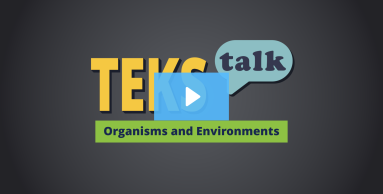
Knowledge and Skills Statement
Provide each group of students pictures of a different set of organisms that would be found in a food chain. An aquatic food chain might include seaweed, shrimp, fish, and birds. A terrestrial food chain might include grass, grasshoppers, birds, and snakes. Also provide students with a set of arrows. Explain that you want them to put the organisms in order based on the energy flow through the food chain. Once each group has put their organisms in order and put the arrows between them, ask the students why the arrows always point towards the organism who is consuming the previous organism. Students should be able to explain that the arrow means that the consumer is gaining energy from the organism it eats.
The further explanation is designed to be a resource for educators that helps them better understand the topic their students are learning. Further explanations may be written at a more complex level than would be expected for students at the grade level.
An example of a food chain in words and in images is provided below
A food chain arranges the organisms in an ecological community according to the order of predation in which each uses the previous member as a food source; may include producers, herbivores, omnivores, and carnivores. As an educator, it is important to know that herbivores, omnivores, and carnivores are all referred to as consumers at this grade level.
Image Attributions/Location:
Grass: Grass icons created by Iconriver - Flaticon
Grasshopper: Grasshopper icons created by BZZRINCANTATION - Flaticon
Research
Keeley, Page. “Formative Assessment Probes: No More Plants: Uncovering Students’ Ideas About Interdependency and Change.” Science and Children 52, no. 8 (2015): 24–25. http://www.jstor.org/stable/43501048.
Summary: There are several common misconceptions that students make about interdependency and food chains. Students may assume that only the next living thing in a food chain is affected if one organism dies off, not realizing how this would affect the entire food chain. This article explains that early childhood students should understand that all animals depend on plants, even animals that do not eat plants at all. Students need to realize that all animals depend on plants, as in their later grades, they will need to understand that plants are the primary source of energy for all animals in food webs. When teaching food chains, teachers should repeatedly trace back to plants at the start of the food chain and ask students other questions about interdependency in an ecosystem.

